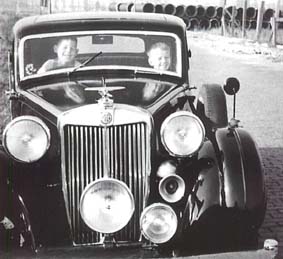

THE FLYING SALOON
VA 2582 was born as a saloon and received its garuanteeplate on 30th of August 1939. It was a late type black saloon with outside doorhinges.
Who the first proud owner was, has not been establisedhed (yet) but not unlikely the war had started before this saloon was delivered.
Eight months later,on the 10th of May 1940, a reservist listening to the name of Jan Moll was operating a Vickers machinegun on the borders of the river Maas which runs through Rotterdam. It was a very heavy fight. After the German supremecy turned out to be too large to conquer, the City of Rotterdam decided to surrender to the German General Hans Graf von Sponeck only 5 days later. Rotterdam was in flames. Heavily bombed by Junckers and Heinkels from the German luftwaffe. In fact most of Holland had surrendered apart from the Province of Zeeland in the south west.
Jan Moll however had other intentions then becoming a prisonor of war. With a couple of fellow officers including Captain Harloff they took some guns and made their way through the country in the South West direction utilising all forms of transport they could lay theirs hands on. They planned to escape to England, but how? All harbours at the Belgium coast as well as the North West of France were either under fire or blocked by magnetic mines.
After a long and exhausting journey they finally managed to find a skipper of a "cognac vessle" which traded a lot with England. He was based in the French harbour of Bordeaux and he was prepared to take them in between his cargo to England.
On the very same day that an armada of British vessels evacuated as many as possible soldiers from the hell of Dunqerke, they sailed safely towards England, finally arriving in Gravesend.
As a civilien Jan Moll was acting as a pilot for the
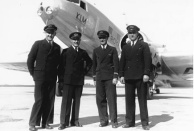 KLM. He had a lot of flying experience though flying the route to the far east and it is also the
very same Jan Moll who was co-pilot on the
DC 2 "De Uiver" which won on handicap
the 1934 London to Melbourne race.
KLM. He had a lot of flying experience though flying the route to the far east and it is also the
very same Jan Moll who was co-pilot on the
DC 2 "De Uiver" which won on handicap
the 1934 London to Melbourne race.
After reporting to the Dutch government in exile in London, Jan was appointed flying instructor with the RAF at Siloth. He only stayed briefly there as he was quickly transferred to Leuchars to become chief instructor of the newly formed 320st squadron, involved in coastel defence. After that he was involved in the transport of brand new Mitchells from the USA to England.
In August 1942 he flew General Alexander to the African front lines with a Liberator 920. In the same year he also did some very dangerous transport to collect SKF bearings in Sweden.
In the second part of the war he did do a lot of flying to Moscow via the Northern Route carrying politicians for negotiations with the Russians.
Towards the end of the war he flew many times to Cairo and Gibraltar carrying military personal.
After hostilities had ended Jan was servicing as a captain for the BOAC for which company he did lineservice from Lyneham to Karachi flying an AVRO York.
In June 1945 Jan was approached again by Mr Plesman from the Royal Dutch Airlines (KLM) and asked if he would come to Holland again to help rebuild the battered Dutch airline company. Although he had a good time with the BOAC Jan would not mind to go home so he gladly accepted. After all he had not seen his wife Ankie since may 1940!
During the war when he was living in England he had gathered so much stuff he wanted to take with him that he decided to buy a motorcar to drive back to Holland.
It was at a London car dealer that he found a very distinghuised gleaming black VA saloon which he found quite a big car and slightly above budget but suiting his purposes.
Before the war Jan had already had a brand new J2 and just before the war he
had bought himself a secondhand red PB. In fact this MG was still waiting for
him hidden away for the invaders in a haystack on a farm near Nieuw Loosdrecht.
before the war he
had bought himself a secondhand red PB. In fact this MG was still waiting for
him hidden away for the invaders in a haystack on a farm near Nieuw Loosdrecht.
The journey home in the VA saloon went via Dunquerke and Antwerp. In Antwerp he knew a large American dump where they had 1000ís of Jerrycans filled with petrol. He found the location and managed to pursuade the attendent to let him have six 20 litre jerrycans to take home.
Once home in Aalsmeer he had the VA maintained by local Fiat dealer Garage Van der Wal. After the VA was imported into Holland is was probably registered GZ 16279. The son of the then garage owner still remembers the gleaming black saloon very well. He also remembers the large aeroplane mascotte (called a "lindbergh mascotte") fitted on top of the radiatorcap. In the event where parts were needed Jan supplied them himself as he flew a lot in between Amsterdam and London.
Around 1950 Jan decides he wants to go back to a smaller car again which fits easier into the garage under his house in Aalsmeer and he buys a new ohv Fiat Topolino.
The VA is sold on to an old friend who had during the war been hiding on the same farm as the PB!
It is Mr M.J.R. Crob, from Amsterdam. It is a young family with 2 sons named Edgar and Martin who are still well alive and remember the MG VA very well.
Mr Crob was a proud owner as the VA was regurlarly washed and polished. As Mr
Crob is a radio technicien the VA gets a "Philinetta" radio and a suitable 220
volts generator under the bonnet. From correspondence, which is still with the
Crop family it appears he received advice on maintenance of the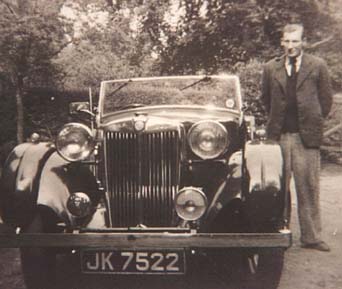 VA from Michael
Bompas from Cambridge. I managed to trace the widow of Michael Bompass and she
provided wonderfull pictures of her late husbandís VA tourer but she could not
remember any "Dutch contact". Michaelís VA tourer, registered JK 7522, which was
apparently green is not known to the SVW Register.
VA from Michael
Bompas from Cambridge. I managed to trace the widow of Michael Bompass and she
provided wonderfull pictures of her late husbandís VA tourer but she could not
remember any "Dutch contact". Michaelís VA tourer, registered JK 7522, which was
apparently green is not known to the SVW Register.
To be able to enjoy touring holidays through Europe the VA saloon gets a tow
bar fitted and it happily tows the Constructam
camping-car type "happy" as far as Italy on many
occasions. In October 1956 the VA receives a new registration number as the old
registration system of personal numbers is being replaced by a new system giving
each car its unique number. It becomes VD-68-60.
the Constructam
camping-car type "happy" as far as Italy on many
occasions. In October 1956 the VA receives a new registration number as the old
registration system of personal numbers is being replaced by a new system giving
each car its unique number. It becomes VD-68-60.
It is 1959 when the VA is replaced by a more modern Opel Kapitein but not before the plane mascotte has been taken off the radiator and put on a nice console as a piece of art in the living room.The VA finds a new owner through the car trader Mr Van Leeuwen from Den Haag.
In June 1959 the saloon is taken on by Mr van der Does. Maurijn as his name is, keeps an excellent record of the money he spends on the VA. He also keeps a notebook in which he writes virtually on a daily base what he is doing to the car and where he travels in it.
Shortly after he has bought the VA 2 nasty things happen. He ruins a big end and he has a blown out tyre. He spends a lot of money rebuilding the engine with the aid of garage Broedelet from Zeist.
He is still studying at Utrecht university and it is the same time that he meets his wife to be: Sabine.
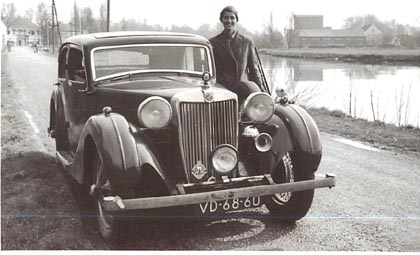
It is his future mother in law that decides to protect him and she presents him with a set of safety belts. Sabine gives him a radiatorcap thermometer as a present. A major repair on the front engine bearing plate needs to be carried out involving a lot of dismantling.
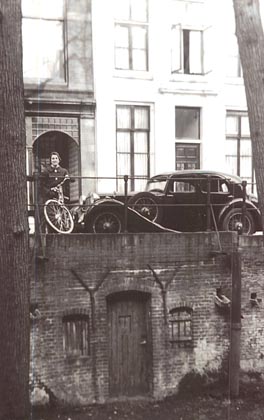
After the useal brake rebuilds, water leakages and several punctures there is a squeeking sound at the rear of the car. Maurijn thinks the shockabsorbers are playing up again but further investigation reveals that the back wheelarches are no
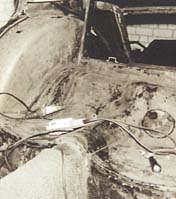
longer firmly attached to the frame! It needs a lot of attention and plaster to repair the wheelarches.
Around the same time an invasion of mice is working its way through the rear seat. They are finally defeated and removed, albeit not before their presence is made clear by a distinct smell.
Finally when the upholstery is repaired, all holes filled and a final coat of black paint on the outside the VA is enjoyed once again.
Many trip are made to the family holiday cottage in Garderen. Although we are
now talking about the 1965 period, Maurijn states in his diary that traffic is
becoming too busy for an old car like the VA. Specially when the exhaust
silencer is gone driving is very tiring. Also driving in the dark and the rain
is not appreciated.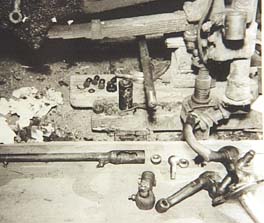
One day Maurijn was on his way to a party in Delft where he had to make a
speech. He was already close to Delft when suddenly the VA strongly veered to
the right and could not be corrected as useal with the steeringwheel. He managed
to stop the MG on the side of the road to find out that a steering ball from the
draglink had popped out of its socket. As he decided it was not safe to drive on
without the ball re attached in a secure way he walked to a local shop to buy
himself some wire. Once back with the VA he noticed a policeman on a bike was
posting next to the car. The policeman was just curieus about what happened and
was very friendly. With the help of the policeman the steeringball was popped
back and secured with wire. All safe again to continue! Maurijn was too late for
his speech. It was later repaired properly.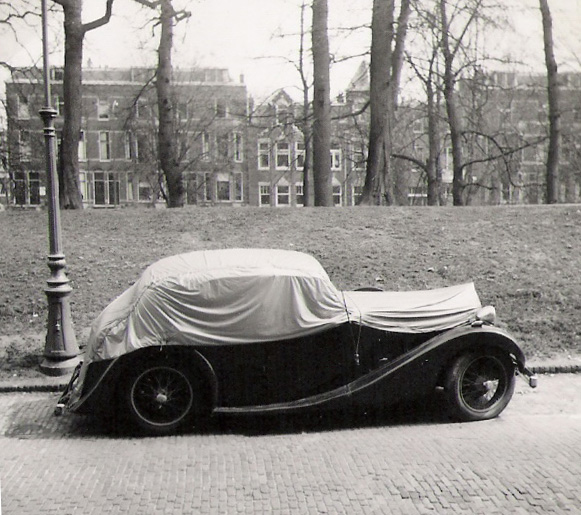
Around 1969 Maurijn reluctanly has to part with the VA. There is no longer a dry garage available for the MG and the body is getting very tired. He has an estimate made by a body builder to have the woodwork professionally replaced and that came to the pricely sum of 17.000 Dutch Guilders. After 10 years of very happy ownership the VA leaves the Van der Does family.
Some more photo's from the van der Does photo album (click on the photo for an enlargement)
After passing through several hands there is a Mr Alfred Kohler who seems to enjoy the ownership of the VA.
At least the VA is pictured and seen running at a
 MG Car Club meeting at
Zandvoort circuit in 1976?
MG Car Club meeting at
Zandvoort circuit in 1976?
Shortly after this meeting a major event takes place in the live of VA 2582. Mr Kohler decides he want to rebuild the saloon and completely dismantles it.
Nobody knows what the real reason was but after a while he obviously gets fed up with the rebuild and sells the dismantled saloon to Hans Compter, a collector and veteran/vintage car trader near Eindhoven.
Hans Compter does not really know what to do with the heap of bits (whoís interested in a VA saloon anyway?) and starts selling of components. Rolf Mobius becomes the proud owner of engine TPBG 2848.
It is April 1980 when I hear of
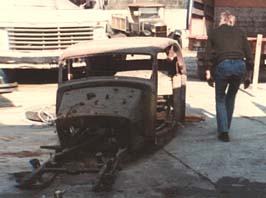 the dismantled VA saloon and I managed to buy
what remained of it: chassis, body, gearbox, axles, instruments, registration
documents, wings etc.
the dismantled VA saloon and I managed to buy
what remained of it: chassis, body, gearbox, axles, instruments, registration
documents, wings etc.
All dismantled and in a very bad state.
It is not untill around 1990 that I find out about the cars early owners and the history of this VA starts intriguing me. In the meantime I had got back the original cylinderblock from Rolf as he had some troubles with it.
A funny thing on the body of this VA is that the nearside doors are pannelled in steel instead of aluminium. Possibly the car was involved in an accident at some stage during the war years as none of the owners I spoke to remembers any accident.
When I found out that most people who were involved with this MG were still
around I decided to put all the bits together and invited them all for some
photo sessions.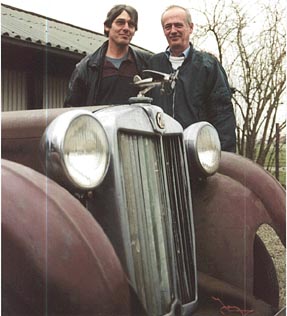
The Crob brothers brought the old plane mascotte they still had in the family
and all parties brought their familie albums cramped with pictures of the car.
Sabine posed again with the VA as she did in 1960 but now with husband Maurijn
who could not be in the earlier photo as he took it !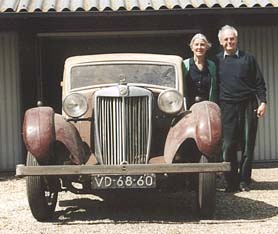
Isn't that what historical research is all about ?